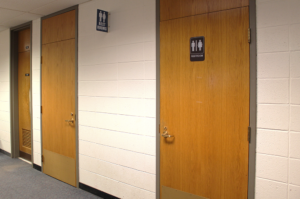Georgetown University began designating 40 single-stall, gender-neutral bathrooms in public buildings throughout campus, an initiative pushed by members of LGBTQ student advocacy groups.
Before the start of the semester, the Office of Planning and Facilities Management received the signs, which are set to identify the new gender-neutral bathrooms, and is in the process of placing them throughout public buildings on campus, according to a university spokesperson.
The LGBTQ Resource Center and Facilities have been working for a year to conduct inspections of single-stall bathrooms in public buildings to ensure that they can be designated as all-gender, according to Director of the LGBTQ Resource Center Sivagami Subbaraman.

Some buildings, such as the Rafik B. Hariri Buildingand Regents Hall, do not have single-stall bathrooms. Although they do have multi-stall bathrooms with handicap-accessible stalls, assigning multi-stall bathrooms as all-gender is not common practice, according to Subbaraman.
The LGBTQ Center used an external consultant to identify which single stall bathrooms in public buildings on campus would satisfy the regulations to be considered all gender, Subbaraman wrote.
The Georgetown University Student Association LGBTQ inclusivity policy team began the initiative to make single-stall restrooms in public buildings on campus gender-inclusive as well as compliant with the Americans with Disabilities Act in March 2017.
The university had already converted many of the larger family bathrooms, such as the bathrooms in the Intercultural Center, into the new gender-neutral bathrooms on campus, according to GUSA LGBTQ+ Policy Chair MacKenzie Grimm (COL ’21).
Still, the university could communicate more openly about its progress on designating gender-neutral bathrooms, Grimm said.
“My first semester, I only knew two gender-neutral bathrooms,” Grimm said. “Even though there has been some progress, the university is not super transparent where they are in the stages of development.”
While most single-stall bathrooms comply with the rules for being assigned as all-gender, not all meet the regulations for handicap access, Subbaraman wrote.
Many of the old buildings met all regulations in place at the time of their construction but have not changed to reflect evolving regulations, according toGrimm.
“A lot of the buildings were made in the fifties, or the sixties, and the stalls are cramped together so it’s not even accessible for anyone at all,” Grimm said.
Although recently the university has been more responsive to students wanting access to single-stall bathrooms, this was not the case last semester, according to Al Castillo (SFS ’22), deputy communications director of GU Pride.
“During my first semester at Georgetown, the option to even access the single-stall bathrooms were unavailable for me,” Castillo wrote in an email to The Hoya. “The single-stall bathroom in the HSFC was always closed, so I was reduced to using the female restrooms. The single-stall bathrooms in Lau were never to be opened.”
In the past, LGBTQ students have voiced concerns over inaccessibility to some gender-neutral bathrooms. Students reported that the single-stall bathrooms meant for all genders were sometimes locked, causing inconveniences for some students.
Using a gendered bathroom has become a source of fear and discomfort for Castillo, who said he tries to avoid gendered bathrooms after experiencing unpleasant stares in both restrooms.
“The last time I used the men’s restroom on campus, the one occupant there quickly stormed off when he caught sight of me,” Castillo wrote. “I feel much more comfortable using the single-stall restrooms because they allow me to not feel pressure from any other occupants for using the ‘wrong’ bathroom.”
The administration has been receptive to student advocacy on gender-neutral bathrooms, according to Crossroads Living Learning Community faculty adviser April Sizemore-Barber. Crossroads is a living learning community centered on gender and sexuality located in Village C East.
“Gender neutral restrooms have been a priority for LGBTQ students on campus for quite some time now,” Sizemore-Barber wrote in an email to The Hoya. “It is great that the university has been responsive to the concerns of students who, essentially, just want to be able to pee in peace.”
The decision to install gender-inclusive signage comes amid reduced national protections for trans students. In recent years, the federal government has overturned previous legislation regarding rules on bathrooms for transgender students. In 2017, President Donald Trump rolled back federal protections for transgender students in public schools, reversing former President Barack Obama’s policy.
The expansion of the gender-neutral restrooms helps to fight the marginalization of trans identities on campus, Sizemore-Barber wrote.
“The university’s action expresses solidarity with and concern for its trans/non-binary students’ wellbeing,” Sizemore-Barber wrote. “The visibility of gender neutral bathrooms will hopefully further normalize trans presence on campus and make trans/non-binary students feel more comfortable and supported while at Georgetown.”




















